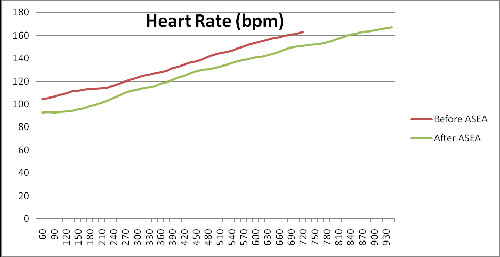|
 |
 |
|||
|
Report for ASEA™ on VO2max Athletic Endurance Enhancement Testing July 2009 |
|||
|
Purpose: This document reports to ASEA™ the results of VO2max athletic endurance testing performed on 17 Athletes from June to July 2009. Experimental Methods for VO2max testing: Seventeen (17) Athletes performed a VO2max test where heart rate (HR), oxygen intake (VO2), Carbon Dioxide outflow (VCO2) and Ventilatory Threshold (VT explained below) were measured during a standard professionally administered VO2max endurance test. Athletes were selected based on their answers on a signed questionnaire that assessed their physical condition and commitment to follow the rules. In order to be qualified, each athlete affirmed that they typically work out rigorously an average of more than 5 hours per week, ate a healthy diet during the test period and was adequately hydrated before each test. Each athlete agreed to follow the rules including maintaining their normal daily routines during the test period and faithfully drinking ASEA™ during the 14 day test period; they abstained from drinking ASEA™ for at least a week before the initial baseline testing. The athletes took the baseline test the week of June 15 before taking ASEA™. The final test, after taking ASEA™ (4 oz. per day) for more than 14 days, was done between June 27 and July 9. Each athlete drank 8 oz of ASEA™ immediately before taking the final test. The VO2max tests were performed on a CardioCoach® system by technicians having more than 5 years experience of administering VO2max tests on this system. The results were analyzed using standard statistical methods for determining Ventilatory Threshold (VT). Detailed explanations are given in the Results section. During the baseline VO2max test, the power output level of the athlete was recorded (the resistance level of the cycle or the speed and incline of the treadmill). This information was used to repeat the same power levels during the final test, making the final test, as far as power output, a repeat of the initial baseline test. If the athlete’s endurance allowed, the test then would be continued at a higher power output until VO2max was detected. This experiment is designed to allow comparison between the performance of a varied group of athletes on the VO2max test before they took ASEA™ to their performance on the same test after taking ASEA™ for more than 14 days and directly before testing. At least 15 athletes were needed in order to have a broader statistical base to measure significant trends. Even though this testing did not have a control group, there was a broad enough base to establish significant trends that can be further studied and verified by controlled double-blind tests on elite groups later on. Physiological Explanation of VT Endurance Measurements: For this experiment, the focus was placed on measuring Ventilatory Threshold (VT), which is widely recognized as a better and more accurate way to measure endurance and power output capacity than VO2max itself. The VT can be measured by comparing the volume of oxygen intake (VO2) to the volume of Carbon Dioxide exhaled (VCO2). As the muscles put out more power, their demand for oxygen from the blood grows proportionally to the amount of waste CO2 they expel into the blood. This is reflected in the VO2 and VCO2 measurements. The body can be thought of as a machine: oxygen (O2) goes into the lungs, passes into the blood where it is pumped into the muscle tissues. There it is combined with sugars and fats to produce the energy needed to sustain the power output. The waste products of aerobic energy production include carbon dioxide (CO2). CO2 is passed back out of the tissues into the lungs where it is then expelled. The amount of O2 going in during aerobic exercise should be directly proportional to the CO2 expelled; this is seen on a graph comparing VCO2 to VO2 as a line. There comes a point, however, during the VO2max test that the power output of the muscles exceeds the ability of the lungs and heart to supply the needed oxygen. At this point an anaerobic process inside the muscle tissues begins to produce energy (energy without oxygen) in order to supply the energy deficit. The waste products of this process include lactic acid and an additional amount of CO2. This anaerobic CO2 waste, combined with the aerobic CO2 waste can be measured as a much increased VCO2 measurement relative to the VO2. This point (VT) can be seen on the VCO2 vs. VO2 graph as a “kink” as the volume of CO2 being expelled goes quickly up to a higher level. VT is defined as the point where VCO2 starts its steeper incline. Thus VT marks the end of pure aerobic energy producing process and the beginning of a mixture of aerobic and anaerobic energy producing processes. This can also be measured with a sharp increase of lactic acid in the blood (usually denoted LT, Lactic Threshold). In this experiment LT is not measured. As lactic acid builds up in the tissues, it inhibits the ability of the tissues to absorb oxygen efficiently, making the aerobic process less efficient. At the Anaerobic Threshold (AT), the build-up of lactic acid begins to spiral up out of control. A few minutes after AT, the carbohydrate supply also runs out and the muscle tissue fails to function. This point of complete exhaustion typically comes several tens of seconds after VO2max, (the point where the body is taking in the maximum amount of O2 possible). VO2max depends on a lot of genetic factors such as lung capacity, heart capacity and the efficiency of the air-blood interface to exchange O2 and CO2 in the lungs as well as the efficiency of the blood-tissue interface in the muscles. Normally VO2max will only significantly increase if lung or heart capacity increases due to long periods of strenuous exercise. VT, on the other hand, is a measure of how much power an athlete is able to sustain at his peak aerobic efficiency. VT can be increased if the blood-air interface in the lungs or blood-tissue interface becomes more efficient in transporting oxygen or getting rid of CO2 and lactic acid. Thus VT is a parameter that it makes sense to target for increase in athletic training. Results of the VO2max testing: The results of the test are presented in summary form with one specific example to illustrate measurements taken and the trends. Average Heart Rate (HR), Average VT, Average VO2max and Average Time to achieve VO2max are reported. Due to experimental error (a loose breathing mask, perhaps), the results for two athletes had to be removed from the averages for VT and VO2max (averaged over 15 athletes). Averages for Heart Rate and Total Time are based on all 17 athletes. Example of results for one athlete As an illustration of the trends seen, one athlete was selected that provided an easily visible example of the trends. His baseline VO2max score was 61.7 (close to the average) before ASEA™ and increased to 68.1 after ASEA™, this was an exceptional increase possibly related to a combination other improvements. His Heart Rate (HR) also was lower during the final test, as evident in the graph (Average HR went from 133 to 121 bpm [beats per minute] over the comparable region).
Also plainly seen on the graph is the difference in the Time to achieve VO2max (the point where the HR graph-line ends). His final VO2max test (with ASEA™) ran almost 4 minutes longer than his baseline test even at the highest power output. Below is shown his VCO2 vs. VO2 graph illustrating the clear “kink” in the data that defines his VT before (diamonds) and after (triangles) ASEA™. He achieved VT at 376 seconds into the test on his baseline test. After ASEA™,VT happened at 498 seconds, a more than 30% increase. This is much larger than the uncertainty in the difference of his power output between the two tests. Also seen is the trend that VCO2 is increasing at a milder rate after taking ASEA™, both before and after VT.
In over 70% of the athletes, similar trends were seen, especially in the VT. Summary of Results The following table gives a summary of the results over all tested athletes as already explained. There is a statistical variance of about 3% on the VT averages; similar uncertainties should apply to all these averages:
Averages Before ASEA After ASEA % Change VT (secs) 306 344 +12% VO2max (ml/kg/min) 62.5 63.6 +3% Heart Rate (bpm) 137 134 -2% Time to VO2max (secs) 639 703 +10% Heart Rate is only measured over comparable regions, as to only compare heart rates at similar power output. An interesting aside, there was no difference in the average heart rate (taken over all athletes) in the interval preceding VT before and after ASEA™ was taken. Observations and Conclusions Based on Results: There is a clear and unequivocal trend in the VO2max data. Based on the data, about 70% of the athletes that try ASEA™ should experience the ability to maintain a higher power output without crossing the Ventilatory Threshold (VT) that instigates fatigue, allowing them to go longer at the same power burn or to operate at a higher power burn than possible before ASEA™. This is based on the most salient feature of the data--the extension of time at similar power levels before the VT and VO2max fatigue-related thresholds. These results deserve more careful investigation and verification. Since 14 days do not give the body enough time to increase lung capacity or cardiovascular capacity, it seems reasonable to conclude that these trends may be more indicative of short range increases in the oxygen-transfer efficiency caused by the ingestion of ASEA™, either at the lungs or in the tissues. It may also be indicative of an increased efficiency in ridding the body of excess lactic acid. This would indicate that ASEA™ would be most effective taken directly before and after exercise. |
|
[Home] [About] [Dr. Dave] [The Science] [VO2max Test] [Athletes] [Learn More] [Join the Team] [Try ASEA] [Helpful Links] [Resources] [FAQ] [Testimonials] [Legal] |

